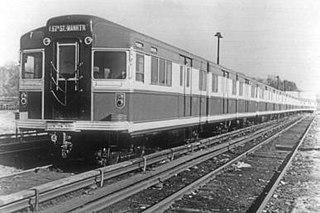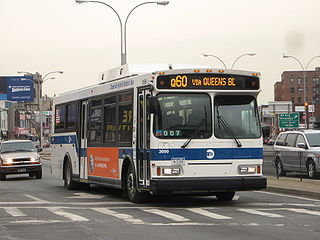
The Brooklyn–Manhattan Transit Corporation (BMT) was an urban transit holding company, based in Brooklyn, New York City, United States, and incorporated in 1923. The system was sold to the city in 1940. Today, together with the IND subway system, it forms the B Division of the modern New York City Subway. The original BMT routes currently form the J/Z, L, M, N, Q, R and W trains, as well as the Franklin Avenue Shuttle, with the IND B, D, and F using BMT trackage in Brooklyn. The M train enters the IND via the Chrystie Street Connection after crossing the Williamsburg Bridge, the Q, along with some rush-hour N trains enter the IND from the BMT 63rd Street Line and the R train enters the IND via the 60th Street Tunnel Connection. The Z train supplements the J in the peak direction during rush hours only. Prior to city ownership, the BMT services were designed with numbers, and the current letter scheme was developed as a continuation of the IND nomenclature as the IND and BMT systems were integrated.

The Brooklyn City Railroad (BCRR) was the oldest and one of the largest operators of streetcars in the City of Brooklyn, New York, continuing in that role when Brooklyn became a borough of New York City in 1898.
Starting in 1899, the Brooklyn Rapid Transit Company and Brooklyn–Manhattan Transit Corporation operated rapid transit lines in New York City — at first only elevated railways and later also subways.

The Bluebird, formally dubbed Compartment Car by its purchaser, the Brooklyn–Manhattan Transit Corporation (BMT), was an advanced design PCC subway and elevated railway car built by the Clark Equipment Company from 1938 to 1940 and used on the New York City Subway system from 1939 to 1955. A total of six units were built, with one prototype and five production units. They were among the last cars to be ordered by the BMT before the city takeover in 1940.

The Fifth Avenue Coach Company was a bus operator in Manhattan, The Bronx, Queens, and Westchester County, New York, providing public transit between 1896 and 1954 after which services were taken over by the New York City Omnibus Corporation. It succeeded the Fifth Avenue Transportation Company.
The Culver Line, Gravesend Avenue Line, or McDonald Avenue Line was a surface public transit line in Brooklyn, New York City, United States, running along McDonald Avenue and built by the Prospect Park and Coney Island Railroad. Most of its main line has been essentially replaced by the IND Culver Line of the New York City Subway.

The Third Avenue Railway System (TARS), founded 1852, was a streetcar system serving the New York City boroughs of Manhattan and the Bronx along with lower Westchester County. For a brief period of time, TARS also operated the Steinway Lines in Long Island City.
The Brooklyn and North River Line, operated by the Brooklyn and North River Railroad, was a trolley line in Manhattan and Brooklyn, New York City, United States. Its route ran from the Desbrosses Street Ferry across Lower Manhattan via the Canal Street Crosstown Line, over a pair of tracks on the east side of the Manhattan Bridge, and to the intersection of Flatbush Avenue and Fulton Street in Downtown Brooklyn. Operation in Manhattan and over the bridge was with conduit electrification, while in Brooklyn it used overhead trolley wire, switching at a plow pit.
The Manhattan and Queens Traction Company, also known as the Manahttan and Queens Transit Company, was a streetcar company operating in Manhattan and Queens County, New York between 1913 and 1937.

The Williamsburg Bridge Plaza, sometimes called Washington Plaza or the Williamsburg Bridge Transit Center, is a major bus terminal and former trolley terminal located at the foot of the Williamsburg Bridge in the New York City borough of Brooklyn, one block west of the Brooklyn-Queens Expressway (I-278). It is situated by the boundaries of Broadway, Havemeyer Street, Roebling Street, and South 5th Street, south of the LaGuardia Playground. It contains five bus lanes, and serves as a terminal for numerous MTA New York City Transit Authority bus routes of Brooklyn and Queens that start and end their runs there.

The Q60 bus route constitutes a public transit line running primarily along Queens Boulevard in Queens, New York City, extending from Jamaica into Midtown Manhattan. It is city-operated under the MTA Bus Company brand of MTA Regional Bus Operations.

The Williamsburg Bridge Trolley Terminal, also called the Essex Street Trolley Terminal or Delancey Street Trolley Terminal, was a trolley terminal located underground adjacent to the Essex Street subway station in the Lower East Side of Manhattan. Passenger trolley service operated through the terminal from 1908 until 1948 when trolley service over the Williamsburg Bridge ended. The station was constructed with balloon loops for turning around streetcars after they crossed over the Williamsburg Bridge to send them back to Brooklyn.

The Q58 and Q58 Limited are bus routes that constitute a public transit line operating primarily in Queens, New York City, with its southern terminal on the border with Brooklyn. The Q58 is operated by the MTA New York City Transit Authority. Its precursor was a streetcar line that began operation in November 1899. and was known variously as the Flushing–Ridgewood Line, the Corona Avenue Line, and the Fresh Pond Road Line. The route became a bus line in 1949.

The Q72 bus route constitutes a public transit route along Junction Boulevard and 94th Street in Queens, New York City. It operates between the Rego Park and East Elmhurst neighborhoods of Queens, and extends into LaGuardia Airport at the north end of the borough. It is city-operated under the MTA Bus Company brand of MTA Regional Bus Operations.

The Manhattan Bridge Three Cent Line was a streetcar company that operated cars over the Manhattan Bridge between the boroughs of Brooklyn and Manhattan in New York City. As the name implied, the fare was only 3 cents per ride.

The Richmond Hill Line is a surface transit line on Myrtle Avenue in Queens, New York City. Once a streetcar line owned by the Brooklyn–Manhattan Transit Corporation, it was replaced on April 26, 1950 by the B55 bus route. The trolley tracks were not removed until April 1955, when Myrtle Avenue was being repaved. The bus was renumbered on December 11, 1988 as the Q55 Myrtle Avenue (East) bus route, operated by the New York City Transit Authority.
The 86th Street Line or Streetcar Line #31 was a streetcar line in Brooklyn, New York City, United States, mostly running along Bath Avenue and other Streets between Coney Island and Sunset Park. Built by the Brooklyn and Queens Transit Corporation as a Streetcar line this route has now been entirely replaced by the B64 bus.














